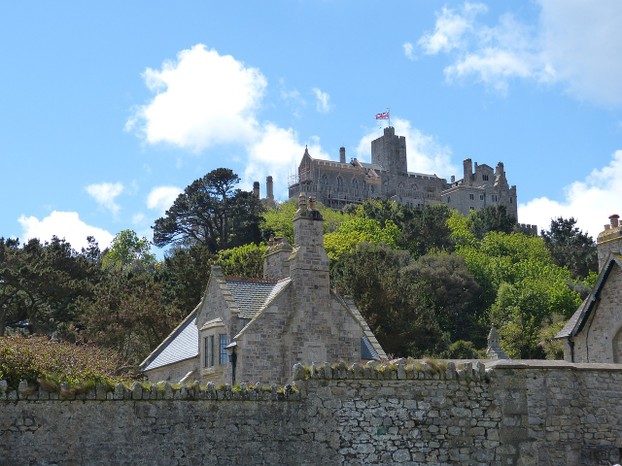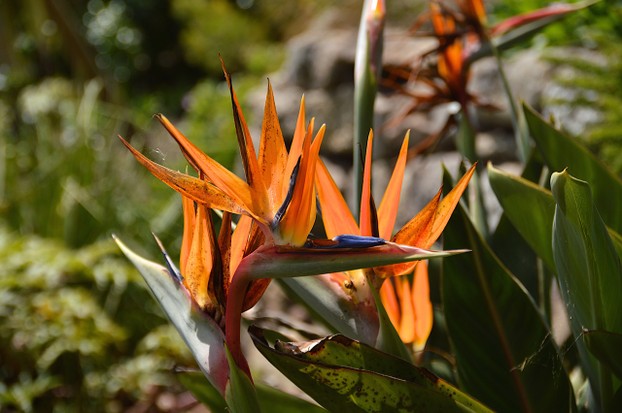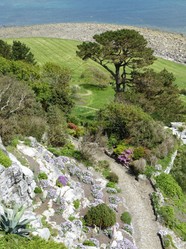We walked the causeway as the tide ebbed and arrived in the harbour. I recommend that you wear boots, as the crossing is wet and the ascent of the rock is steep and stony. You also need to be wary of tide times to prevent you from becoming temporarily stranded on the isle.
You begin your ascent in the small village that houses the community of thirty five residents in sturdy granite cottages, very typical of Cornwall. and then having passed through the outer wall ascend the steep, cobbled path to the castle. The summit contains the castle proper and the church, which is a mediaeval foundation pre-dating the reformation. There are good views from the castle walls over Cornwall and the sea, and you ponder upon the generations of sentries who patrolled those ramparts scanning the seas for pirate xebecs [fast raiding ships.]
Much of the castle is devoted to the museum, which contains a variety of artefacts, which includes costumes and a fair amount of antique arms and body armour dating from the times when the castle was a necessary defence against the barbary pirates,North African raiders who plundered and enslaved in the channel for centuries until the British finally suppressed them in 1816. Sturdy defences against these thugs were necessary, for they were not afraid to land and carry off their victims. But weapons are not my favourite museum items, I am more interested in works of art, be they paintings,sculptures or textiles, and there are some of these in the small museum. Tourists cannot, though, enter the private apartments of the family.
The church is unique in not being affiliated to any denomination, but it is at the service of the order of St John, an ancient order of chivalry still established in the British state. It is descendant of the mediaeval order of the knights of Malta, with whom the St Aubyn family have some connection.
There is a strange room in the church only discovered about 150 years ago. It is believed to be an anchorite's cell. An anchorite was a hermit attached to the church. Some were anchoresses. They heard mass through a grill and were taken food by a servant. But this cell contained a skeleton of a man seven foot eight inches tall. A dead anchorite would have been taken out to be buried, so this is unlikely to have been a monk. Rather I suspect that a castle owner, maybe one of the St Aubyn family's predecessors after the monks had been expelled, had in an act of sacrilege defiling the old church used the cell as an oubliette, a cramped dungeon where the prisoner was incarcerated, forgotten and left to die, starving and alone. It is said that St Michael's Mount has but few ghosts [many British castles have them] but some people occasionally report seeing the shade of a very large man. Imagination or what? There are things in heaven and earth not understood by philosophy or science.
But the church has a pleasant atmosphere. It is light and spacious, not very large. Places acquire an atmosphere from the events that have happened in them,and give or take the incident discussed in the previous paragraph, I get the feeling that mostly good things have happened there.
St Michael's Mount is well worth a visit if you are visiting Cornwall.









 Pilgrimage. A review22 days ago
Pilgrimage. A review22 days ago
 Leo the Fourteenthon 05/09/2025
Leo the Fourteenthon 05/09/2025
 The Melsonby Hoardon 03/25/2025
The Melsonby Hoardon 03/25/2025



Comments
Modern law supercedes ancient traditions.all deals nowadays are in written contracts.
Thank you for your comment below in answer to my previous observation and question.
It's impressive that udal law impelled as ingredients acquaintance, community, tradition and trust to initiate and institutionalize its land-tenure inheritance.
But how might that move where udal law meets non-udal law in modern matters?
Might non-udal law mandate sworn statements about how such land and water rights moved from one named family to another over time?
Or might the udal-law tradition of trusting one another matter?
Udal ope4ated in a community based on bonds of trust in a traditionalonal community in which families knew each other
Thank you for your comment May 14, 2024, in answer to my previous observation and question May 13, 2024.
Online sources describe udal-law tenure as not demanding written title deeds.
How is such tenure indicated and inherited?
Morn is a dead language, but some words survive in dialects.
Thank you for your comment below in answer to my previous observation and question.
Norse-language survivals intrigue me what with my maternal-line Norse heritage that inhabited every Irish county and Orkney.
So "residual words derived" from Norn means no present-day Norn speakers.
Might there have been, or will there possibly be Cornish-like, Norn-speaking revival attempts?
Orkney does not have any living Norse dialect, but Fair Isle, a remote and isolated isĺe between the two archipelagos, has residual words derived from Norm, a Norse language oncevspokennin the North of the British Isles.
Thank you for your comment below in answer to my previous, same-day observation and question.
The Scandinavian influence in Orkney and Shetland causes me to consider spoken and written languages there.
Might Orkney and Shetland have their own Norse-descended languages?
Orkney and Shetland were only joined to Scotland innthe fifteenth century. They havevavstrong identity of their own,
Thank you for your comment below in answer to my previous, same-day question.
It intrigues me that Orkney law invokes ancient Norse law even as ancient Norse law perhaps informed other areas of the British Isles.
Is Orkney managing to be different because Norse bloodlines and Norse heritage offer their strongest British-Isles expression there?